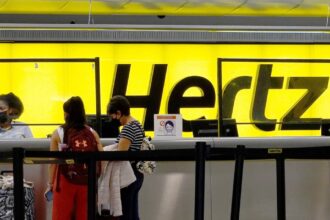You’re not the only one who’s irked at having to return that new shirt that didn’t quite fit. Retailers are also dreading the onslaught of returns that follows the holiday season.
Roughly $148 billion in returns are expected to hit warehouses in the weeks following the holiday season, according to a joint report from the National Retail Federation and return company Appriss. That comes on the heels of customers returning about $743 billion worth of merchandise in 2023, which accounted for about 14.5% of total retail sales last year.
While returns have long been a nuisance for retailers, higher labor and transportation costs have made the industry especially reluctant to process them this year. According to the latest consumer price index report, transportation costs jumped 9.7% in December from a year prior. Meanwhile, hourly wages for transportation and warehouse workers increased 6% in December from a year ago.
A report from logistics company Optoro found that it costs between 20% to 39% of an item’s price to process it as a return between postage, packaging, product depreciation, labor, and the missed sales opportunity.
Perhaps more worrisome for retailers, costs are rising just as sales growth is poised to slow. That could pressure margins at a time when investors are laser-focused on margin expansion. According to a survey from return logistics company goTRG, 49% of retailers now find returns to be a “severe” problem, up from 2% of survey respondents a year ago.
“When your sales aren’t growing, and you have continued pressure on performance and revenue’s not going up, you’ve got to eke out more margin,” said Jonathan Poma, CEO of
Loop
Returns.
So this year, many companies are ramping up their efforts to stymie the swarm of postholiday returns. Nine in 10 respondents said they had increased their return logistics investments compared with the prior year, the goTRG survey found, with most investing between $1 million to $5 million.
Some are trying to address the problem from the moment consumers first put an item in their cart by providing better descriptions on sizing and fit. Others are shortening their return windows after the holiday, offering store credit instead of refunds, or simply urging customers to keep certain items—especially less expensive ones—rather than returning them. From Dec. 26 to Jan. 1, returns company Loop Returns saw a nearly 40% increase in the number of merchants using “keep item” policies, the company said.
And while those initiatives will help, the main line of defense for retailers is one that will likely face the biggest pushback from consumers: tacking on return fees for mailed-in orders.
Choosing to impose return fees isn’t a decision retailers make lightly, as it could come at the expense of customer satisfaction and retention, said goTRG CEO Sender Shamiss. Even nudging customers into stores, which might seem like a win-win, could result in some pushback, especially from customers like Anjali Punnoose, 26, who have grown partial to mailed returns.
“It’s just such a process to have to go back to the store and return it because that’s the whole thing we’re trying to avoid — being in stores with so many people and just trying to avoid the madness, especially during the holiday season,” said Punnoose, who lives in Tampa, Fla.
Just under half of retailers—49%—said they began imposing shipping or restocking fees this holiday season, according to the goTRG survey. The goal? To encourage customers to bring their unwanted items back into stores, which not only cuts down on the processing cost for retailers, but could also result in more foot traffic. Many companies, including
Macy’s,
Kohl’s,
Urban Outfitters,
and
American Eagle Outfitters,
all have fees for certain mailed returns but offer free returns in store.
“That’s the new thing with returns,” Shamiss said. “Everybody wants to charge fees for mailing them back, and everybody wants to encourage people to come back into some sort of retail environment to spend more dollars.”
Even
Amazon.com
—which pioneered the advent of free, easy returns—has scaled back its sweeping approach. Although most return options are still free, the company now charges $1 for customers to return their package through UPS. Amazon’s largest competitors, such as
Target,
Walmart,
and
Costco Wholesale,
have kept returns free.
Fees didn’t seem to faze Punnoose—as long as the returns process was more convenient. One of her more positive returns experiences lately was with apparel company
Abercrombie & Fitch,
which charges $7 for mailed returns, according to its website, but provides a preprinted return label alongside her original purchase that makes it easy to drop the package off at her local post office.
The convenience aspect is important for any retailer looking to add return fees, experts say.
“There is a quid pro quo, where if you’re going to charge a fee and add a little bit of friction to the process, it had better be a great experience,” Poma said, the Loop Returns CEO, said.
To counter the consumer pushback, some companies let members of their loyalty programs return items for free, which experts say is paving the way for a more personalized approach to returns. Retailers will soon be offering regular shoppers discounted return fees even if they’re not part of a formal loyalty program, Poma said. But that’s still a few years away, he added, as the industry builds out the software and logistics needed.
Write to Sabrina Escobar at [email protected]
Read the full article here










